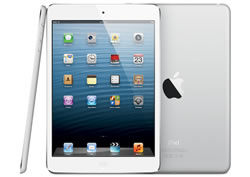Difference between Microsoft Surface Pro and iPad
Key difference: At the time of its release, the Microsoft Surface was touted as the perfect cross between a tablet and a laptop. It was initially released February 2013. The Microsoft Surface Pro features a 10.6-inch ClearType HD screen with approximately 208 ppi pixel density. The screen is full HD, a feature not readily avilable in most tablets. The device runs Microsoft Windows 8, which the same OS that is being run in various laptops and desktops. The device has Full Windows capability. It can practically run all Windows programs, including games. iPads have the screen size of 9.7 inches with multi-touch display. iPads are intended as devices for a multimedia experience, reading e-books, watching movies, listening to music, playing games, browsing the Internet, or retrieving e-mail. The company is currently on the iPad fourth-generation, also known as just plain iPad or iPad 4.

Today is the world of smartphones and tablets. So, much so that tablets and smartphones are attempting to replace the traditional and bulky desktops and laptops. The Microsoft Surface is a series of tablets that aim to do just that. The advantage that the Surface has over a number of other tablets is that it will run the Microsoft Windows operating system, whereas most other tablets run Android. The iPad runs the iOS which is more similar to the iPhone OS rather than a Mac OS. Hence, at the time of its release, the Microsoft Surface was touted as the perfect cross between a tablet and a laptop. It was initially released February 2013.
The Microsoft Surface Pro features a 10.6-inch ClearType HD screen with approximately 208 ppi pixel density. The screen is full HD, a feature not readily avilable in most tablets. The screen affords the true 16:9 aspect ratio which matches most movies and shows, eliminating the black bars that pop up. The Microsoft Surface Pro also has a 10 point multi-touch.
Microsoft Surface Pro is powered by a Dual-core 1.7 GHz Intel Core i5-3317U processor, which is backed by 4 GB of RAM. It also features two cameras, a front-facing and a rear-facing. Both are 720p HD LifeCams with True Color.
The device runs Microsoft Windows 8 Professional, which the same OS that is being run in various laptops and desktops. The device has Full Windows capability. It can practically run all Windows programs, including games.
The device comes in three memory size variants: 64 GB, 128 GB and 256 GB. However, the actual memory storage available for the user is 23GB for the 64 GB variant and 85GB for 128 GB variant. The actual user memory available for the 256 GB is not currently specified. The size disparency is because of the system backup storage recovery partition, which can be manually deleted by experiences users.
The input devices for the Microsoft Surface Pro includes an on screen keyboard, a physical keyboard that doubles as a cover, as well as a pen stylus. The physical keyboard can be purchased separately or as part of a combo with the device itself. It attaches magnetically and electrically to the base of the tablet.
Physically, the device is quite similar to the Microsoft Surface RT, same look, and same color. However, it is thicker than the RT and has a full USB 3.0 port, in addition to a Micro-HDMI port, microSDXC card slot, Headset jack, Mini DisplayPort and Cover port. Similar to RT, it also has a built in kickstand, which has been critized by some as beinf too difficult to manage. Additionally, Microsoft has also acknowledged issues with the stylus pen. The stylus pen has been reported by some users as randomly not working correctly, especially with older applications that do not have complete pen support. There have also been some reported issues with Wi-Fi and while waking up from standby mode.
 Apple originally launched iPad in 2010. Its launch started a new trend for tablets. iPad is a type of tablet PC, which was originally promoted as a cross between an Apple iPhone and iPod Touch with added capabilities of computing. However, it is not meant to be a replacement for desktop personal computers or laptops. iPads have computational properties that can do some tasks as laptops but not all. The company is currently on the iPad fourth-generation, also known as just plain iPad or iPad 4.
Apple originally launched iPad in 2010. Its launch started a new trend for tablets. iPad is a type of tablet PC, which was originally promoted as a cross between an Apple iPhone and iPod Touch with added capabilities of computing. However, it is not meant to be a replacement for desktop personal computers or laptops. iPads have computational properties that can do some tasks as laptops but not all. The company is currently on the iPad fourth-generation, also known as just plain iPad or iPad 4.
iPads have the screen size of 9.7 inches with multi-touch display. iPads are intended as devices for a multimedia experience, reading e-books, watching movies, listening to music, playing games, browsing the Internet, or retrieving e-mail. It has a software structure more like that of a mobile phone. It also has a very simple user interface, which can even be easily operated by children. iPads are available with a memory capacity of 16 GB, 32 GB, 64 GB and 128 GB.
The iPad is available in models supporting only Wi-Fi, or 3G and Wi-Fi. However, iPad lacks Flash, software that a number of websites use to display content. So, iPad cannot load these pages. This limits the web surfing experience. The fourth-gen iPad is similar to its predecessors, while it still has two minor and one major upgrade on it. The 30-pin connector has been upgraded to a smaller Lightning connector, while the front camera has been upgraded to the HD Status. The major upgrade is the new A6X processor that replaced the A5X processor on the third-gen. The iPad Mini version is a smaller and thinner version of the iPad.
The information for the detailed table about the two devices has been taken from the Microsoft website, Apple website, GSMArena.com and Wikipedia.
|
|
Microsoft Surface Pro |
iPad (4th generation) |
|
Launch Date |
February 2013 |
November 2, 2012 |
|
Company |
Microsoft |
Apple |
|
Size |
275 x 173 x 13 mm |
241.2 x 185.7 x 9.4 mm (9.50 x 7.31 x 0.37 in) |
|
Display |
10.6 inches ClearType HD screen |
LED-backlit IPS LCD, capacitive touchscreen, 16M colors |
|
Screen |
1920 x 1080 pixels (~208 ppi pixel density) 16M colors |
1536 x 2048 pixels, 9.7 inches (~264 ppi pixel density) |
|
Protection |
VaporMg casing |
Scratch-resistant glass, oleophobic coating |
|
Weight |
910 grams |
652g (1.44 lb) 662g (1.46 lb) for 3G model |
|
2G Network |
N/A |
(Wi-Fi + Cellular Model) GSM 850 / 900 / 1800 / 1900 - A1459/ A1460 (Wi-Fi + Cellular Model) CDMA 800 / 1900 / 2100 - A1460 |
|
3G Network |
N/A |
(Wi-Fi + Cellular Model) HSDPA 850 / 900 / 1900 / 2100 - A1459/ A1460 (Wi-Fi + Cellular Model) CDMA2000 1xEV-DO - A1460 |
|
4G Network |
N/A |
(Wi-Fi + Cellular Model) LTE 700 MHz Class 17 / 1700 / 2100 - A1459 (Wi-Fi + Cellular Model) LTE 700 / 850 / 1800 / 1900 / 2100 - A1460 |
|
GUI |
Windows 8 Pro |
iUI |
|
CPU speed |
Dual-core 1.7 GHz Intel Core i5-3317U |
Dual-core 1.4 GHz |
|
GPU |
Intel HD Graphics 4000 |
PowerVR SGX554MP4 (quad-core graphics) |
|
OS |
Windows 8 Pro |
iOS 6 |
|
Chipset |
Intel Core i5 |
Apple A6X |
|
RAM |
4GB RAM—Dual Channel Memory |
1 GB RAM |
|
SIM Size |
N/A |
Micro-SIM for 3G model |
|
Internal Memory |
64/128/256 GB |
16/32/64/128 GB |
|
Expandable Memory |
microSDXC card slot |
None |
|
Sensors |
Ambient light sensor, Accelerometer, Gyroscope, Compass |
Accelerometer, Gyroscope, compass |
|
Connectivity |
Wi-Fi, Wi-Fi direct, Bluetooth, USB |
Wi-Fi + Cellular Model GSM/EDGE (850, 900, 1800, 1900 MHz) UMTS/HSPA+/DC-HSDPA (850, 900, 1900, 2100 MHz) LTE (Bands 4 and 17) Wi-Fi + Cellular Model (MM) CDMA EV-DO Rev. A and Rev. B (800, 1900, 2100 MHz) GSM/EDGE (850, 900, 1800, 1900 MHz) UMTS/HSPA+/DC-HSDPA (850, 900, 1900, 2100 MHz) LTE (Bands 1, 3, 5, 13, 25) Data only All Models 802.11a/b/g/n Wi-Fi (802.11n 2.4GHz and 5GHz) Bluetooth 4.0 wireless technology |
|
Data |
WLAN, Bluetooth, USB |
WiFi, USB GPRS, EDGE, LTE for Wi-Fi + Cellular Model |
|
Speed |
- |
DC-HSDPA, 42 Mbps; HSDPA, 21 Mbps; HSUPA, 5.76 Mbps, LTE, 73 Mbps; EV-DO Rev. A, up to 3.1 Mbps |
|
WLAN |
Wi-Fi (802.11a/b/g/n) |
Wi-Fi 802.11 a/b/g/n, dual-band, Wi-Fi hotspot |
|
Bluetooth |
Bluetooth 4.0 Low Energy technology |
Bluetooth v4.0 with A2DP |
|
USB |
Full-size USB 3.0 |
USB v2.0, special lightening charger |
|
Primary Camera |
720p HD LifeCams with True Color |
5 MP, 2592 x 1944 pixels, autofocus |
|
Secondary Camera |
720p HD LifeCams with True Color |
Yes, 1.2 MP, 720p@30fps, face detection, FaceTime over Wi-Fi + Cellular |
|
Video |
720p @ 30fps |
1080p@30fps, video stabilization |
|
Camera Features |
Geo-tagging |
Touch focus, geo-tagging, face detection |
|
Sound Enhancement |
Microphone, Stereo speakers |
No |
|
Audio supported formats |
MP3/ WAV/ eAAC+ player |
AAC (8 to 320 Kbps), Protected AAC (from iTunes Store), HE-AAC, MP3 (8 to 320 Kbps), MP3 VBR, Audible (formats 2, 3, 4, Audible Enhanced Audio, AAX and AAX+), Apple Lossless, AIFF and WAV |
|
Video supported formats |
MP4/ DivX/ Xvid/ H.264/ H.263 player |
H.264 video up to 1080p, 30 frames per second, High Profile level 4.1 with AAC-LC audio up to 160 Kbps, 48kHz, stereo audio in .m4v, .mp4 and .mov file formats; MPEG-4 video up to 2.5 Mbps, 640x480 pixels, 30 frames per second, Simple Profile with AAC-LC audio up to 160 Kbps per channel, 48kHz, stereo audio in .m4v, .mp4 and .mov file formats; Motion JPEG (M-JPEG) up to 35 Mbps, 1280x720 pixels, 30 frames per second, audio in ulaw, PCM stereo audio in .avi file format |
|
Battery Capacity |
42 W-h |
Built-in 42.5-watt-hour rechargeable lithium-polymer battery |
|
Available Colors |
Dark Titanium |
Black, White |
|
Messaging |
Email, Push Email, IM |
iMessage, Email, Push Email, IM |
|
Browser |
HTML5 |
HTML (Safari) |
|
Radio |
No |
No |
|
GPS |
Yes |
with A-GPS support and GLONASS |
|
Java |
- |
None |
|
Additional Features |
|
|
Image Courtesy: microsoft.com, pluggedin.co.uk









Add new comment